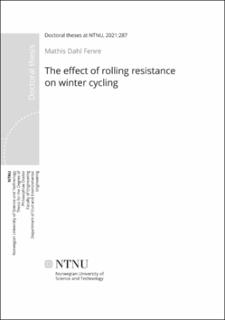| dc.contributor.advisor | Klein-Paste, Alex | |
| dc.contributor.advisor | Wåhlin, Johan | |
| dc.contributor.author | Fenre, Mathis Dahl | |
| dc.date.accessioned | 2021-09-02T09:08:27Z | |
| dc.date.available | 2021-09-02T09:08:27Z | |
| dc.date.issued | 2021 | |
| dc.identifier.isbn | 978-82-326-5420-8 | |
| dc.identifier.issn | 2703-8084 | |
| dc.identifier.uri | https://hdl.handle.net/11250/2772483 | |
| dc.description.abstract | Authorities in many countries facilitate increased bicycle use in urban areas due to its numerous benefits. Still, the number of bicycle trips drops drastically during the wintertime, especially in areas with harsh winters. Inclement road conditions have been identified as a significant "barrier" to winter cycling. Moreover, previous research has found that better winter maintenance can significantly increase winter cycling. Quantitative knowledge about how the road conditions affect winter cycling is needed to improve winter maintenance and evaluate its costs and benefits. A quantifiable metric that describes the road condition quality would be helpful to investigate this correlation. A quantifiable metric that describes the road condition quality would be helpful to investigate this correlation. Rolling resistance equals the energy needed for a wheel to roll over a surface at a constant speed. It is directly dependent on surface irregularities and road contaminants such as snow or ice. Snow, ice, and uneven surfaces can all reduce cycling comfort and increase rolling resistance, making cycling more physically demanding. Therefore, rolling resistance shows potential as a valuable metric for quantifying the quality of cycleways under winter conditions.
The following work is outlined in this dissertation: A) A new measurement method for bicycle rolling resistance was developed using an instrumented bicycle. The method measured propulsive and resistive forces acting on the moving bicycle and utilized the force equilibrium to estimate the rolling resistance. B) This method was used to measure rolling resistance on various winter conditions and analyze the correlation between rolling resistance and perceived cycling comfort. C) These analyses were later used in an online survey to investigate the correlation between rolling resistance and people's stated willingness to cycle during the winter. The respondents (N=1318) based their answers on conditions shown in photos.
The results show that the developed method can measure the coefficient of rolling resistance, Crr, with a precision, represented as the standard error of the mean, of ±0.005 (1 Hz, n = 9) or ±0.002 (1 Hz, n = 55), depending on the number of recorded samples. The new method measured significant differences in rolling resistance between ten typical winter conditions. The Crr varied between around 0.01 on bare asphalt to around 0.06 in deep loose snow. The results also showed a negative correlation between rolling resistance and cycling comfort. The survey results showed that the cycling willingness among regular winter cyclists decreased close to linearly from around 90% to 19% for rolling resistances between Crr=0.01 to Crr=0.06. Summer-only cyclists showed a close to exponential decay in cycling willingness from around 70% to 7% for the same rolling resistance interval. The use of studded tires significantly increased cycling willingness while electric bicycle use did not. Low temperatures (29%) and a lack of safety (27%) were the main reasons for not cycling during the winter.
The results indicate that increased use of studded tires and slight winter maintenance improvements can increase the cycling frequency of regular winter cyclists. To recruit summer-only cyclists to winter cycling, it is necessary to provide cycleways with conditions perceived as safe and comfortable and low rolling resistance, preferably with Crr levels below 0.01. | en_US |
| dc.language.iso | eng | en_US |
| dc.publisher | NTNU | en_US |
| dc.relation.ispartofseries | Doctoral theses at NTNU;2021:287 | |
| dc.relation.haspart | Paper 1: Fenre, Mathis Dahl; Klein-Paste, Alex. Rolling Resistance Measurements on Cycleways Using an Instrumented Bicycle. Journal of cold regions engineering 2021 ;Volum 35.(2) https://doi.org/10.1061/(ASCE)CR.1943-5495.0000244
This work is made available under the terms of the Creative Commons Attribution 4.0 International license, https://creativecommons.org/licenses/by/4.0/. (CC BY 4.0) | en_US |
| dc.relation.haspart | Paper 2: Fenre, Mathis Dahl; Klein-Paste, Alex. Bicycle rolling resistance under winter conditions. Cold Regions Science and Technology 2021 ;Volum 187. s. 1-11 https://doi.org/10.1016/j.coldregions.2021.103282
This work is made available under the terms of the Creative Commons Attribution 4.0 International license, https://creativecommons.org/licenses/by/4.0/. (CC BY 4.0) | en_US |
| dc.relation.haspart | Paper 3: Fenre, Mathis Dahl; Klein-Paste, Alex. The effect of rolling resistance on people’s willingness to cycle during wintertime. Journal of Infrastructure Preservation and Resilience 2021 ;Volum 2. https://doi.org/10.1186/s43065-021-00022-5
This work is made available under the terms of the Creative Commons Attribution 4.0 International license, https://creativecommons.org/licenses/by/4.0/. (CC BY 4.0) | en_US |
| dc.relation.haspart | Paper 4:
Fenre, Mathis Dahl; Klein-Paste, Alex
A torque-based method for measuring bicycle braking friction. | en_US |
| dc.title | The effect of rolling resistance on winter cycling | en_US |
| dc.type | Doctoral thesis | en_US |
| dc.subject.nsi | VDP::Technology: 500::Environmental engineering: 610 | en_US |
